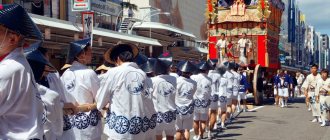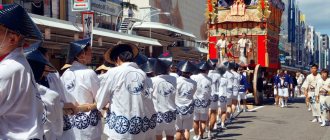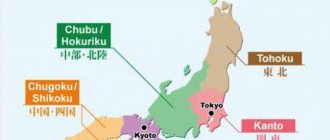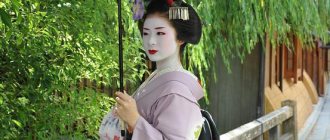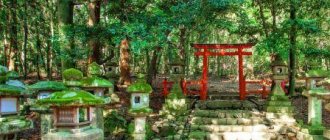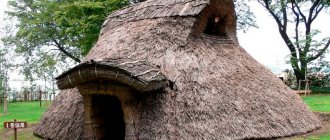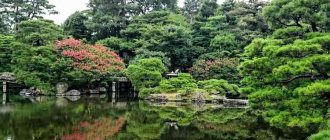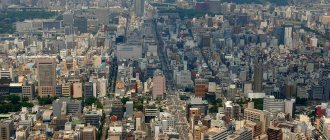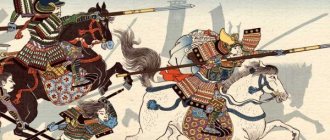Art and Architecture of Ancient Japan
Details Category: Fine arts and architecture of ancient peoples Published 01/05/2016 15:05
The history of Ancient Japan begins with the Paleolithic and ends with the Heian period.
Conventionally, the history of ancient Japan is divided into 3 large stages, which are divided into smaller historical periods (jidai).
Historical periods of Ancient Japan
First stage: prehistoric Japan (primitive society)
It includes 3 periods: the Japanese Paleolithic (no later than the 40th millennium BC and before the appearance of Neolithic tools of the 12th millennium BC); Jomon (from 13,000 BC to 300 BC, the beginning of the creation of ceramic products). Corresponds to the Mesolithic and Neolithic;
Ceramic product of the 3rd millennium BC. e. Yayoi (300 (900) BC – 250 (300) AD). Corresponds to the Bronze and Iron Ages.
Second stage: formation of Japanese statehood
It consists of 2 periods: Kofun (250 (300) - 538). The spread of the kurgan culture and the emergence of the Japanese state of the same name in the Yamato region.
Daisenryo mound. Aerial view. Tomb of Emperor Nintoku (early 5th century) Asuka (538-710). The spread of Buddhism, the emergence of a centralized Chinese-style state, the creation of the first set of laws and the flowering of Japanese culture.
The oldest wooden structure in the world is the five-story pagoda of Horyu-ji Temple, built by Prince Shotoku
Third stage: “State of laws”
This stage is divided into two periods: Nara (710-794). The period began with the restoration of the state capital in the modern city of Nara and ended with its transfer to the modern city of Kyoto. During this period, the accelerated sinicization of Japanese society began, the creation of the first historical chronicles and the flourishing of Buddhist culture and poetry.
Great Buddha Vairocana at Todai-ji Temple (Nara, 752) Heian (794-1185).
The word "Heian" means peace and tranquility. In accordance with these historical periods, we will consider ancient Japanese art.
Edo era (1603-1867)
After the death of Toyotomi Hideyoshi in 1598, Tokugawa Ieyasu, an associate of Toyotomi, became involved in the struggle for power. He promised to take care of the son and family of the former ruler, but broke his word. In 1603, Tokugawa Ieyasu was proclaimed shogun and established his own government in the city of Edo. The reign of the Tokugawa shogunate lasted 250 years.
During his reign, Ieyasu distributed the land among the daimyo. Those who supported him even before coming to power received the best (strategically important) plots. The entire population of the country was divided into 4 classes. At the top of the pyramid was the samurai class. Below were merchants, artisans and peasants. There was also a fifth class - it included “pariahs” (people with “dirty” occupations and professions). Changing “one’s” class and profession was strictly prohibited.
Much attention was paid to trade relations - connections were established with Germany and England.
The Tokugawa clan had virtually no strong opposition, so this period in Japanese history can be called quite peaceful and quiet. In order to prevent the weakening of his power, the ruler prohibited Christianity (in 1614), in 1633 he prohibited long-distance voyages, and in 1639 he completely limited foreign relations to trade with China. All foreign books were banned at that time. Japan remained closed to outside influence until 1868. This fact significantly influenced the level of development of the country, because the country did not have the opportunity to adopt the scientific and technical discoveries of the world.
Jomon period
The production of ceramics began. At the beginning of this period, a vertical pattern was applied to the vessels (individual plant fibers were laid on raw clay). Then they began to weave the threads, applying a pattern with horizontal stripes in the form of a herringbone. The mid-Jōmon period featured a diagonal pattern, while the late period was dominated by a geometric pattern. People of the Jomon period already knew how to make earrings from shells, stone, clay and teeth of wild animals, as well as bracelets and necklaces from shells and stones, combs from bones, urushi varnish, rough clothing from skins and primitive fabric. Clay figurines of dogu, which had a ritual character, also date back to this period.
Dogu In many Jomon period dwellings, archaeologists have discovered carefully crafted stone stupas (ishizara), indicating the first steps in the development of agriculture, and long stone staffs (sekibo) of unknown purpose.
Japanese worldview
Harmony with nature is a necessity for the Japanese. They learned from the world, not fought with it. By improving the environment, people improved themselves. Life in peace with nature is harmonious, otherwise a person cannot achieve balance.
Even Eastern martial art was connected with the outside world. Some blows are similar to the habits and movements of animals:
- monkeys;
- tigers;
- snake;
- bears.
The Japanese are always true to their traditions. Anyone who violated the rituals was considered a traitor. Here they believe in a vicious circle of all living things. It is believed that one’s own destiny is impossible and should not be changed.
Yayoi period
Vessel from the Yayoi period (1st-3rd century AD)
Ceramics of the Yayoi period became more unified and utilitarian (vessels and other utensils for purely household purposes predominated), with simpler ornamental decoration. Large-scale migrations began from the Korean Peninsula, which brought to Japan the technique of flood rice growing, bronze and iron production, and silk weaving.
Reconstruction of a typical Yayoi period fortification
Osaka is a national center for entertainment and theater
In terms of the size of Japanese cities, Osaka ranks third. The metropolis is full of life, energy, where there is everything you need for a great time. The city is more permeated with Japanese culture than the capital; the atmosphere and character of Japan are very noticeable. The residents here, according to tourists, are friendly, spontaneous, and sincere. They are famous throughout the country for their great love of food and business acumen. The culinary center of the country is located here; guests can try a variety of dishes, national delicacies, restaurant and street food.
There are many attractions, Osaka is called the Venice of Japan; the metropolis has many lakes, streams, canals, bridges in various architectural styles. Ancient temples have been preserved, which are located next to modern skyscrapers and amusement parks. Must-see attractions in Osaka:
- Bunraku National Theatre;
- national art museum;
- ramen museum (instant noodle museum);
- chess park;
- Osaka Kaiyukan Aquarium;
- Japanese Disneyland;
- Umeda Sky Building;
- science museum;
- Organic Building;
- Sumiyoshi-taisha Temple;
- kingdom of crabs;
- Poisonous fugu fish restaurant.
Kofun period (mound)
It was named after numerous burial mound-type structures, which indicates the social stratification of society. The study of mounds began in the 17th century. and by the end of the 20th century. more than 10 thousand of them were discovered. During the Kofun period, the spread of Buddhism began, which later played the role of a national ideology.
Kofun Period Mound (Nara Prefecture) During the Kofun Period, writing (Chinese characters borrowed from Korea) began to spread across the archipelago. A striking example of ceramics from the Kofun period are Haniwa ritual sculptures, the manufacturing technology of which shows continuity with the ceramics of the Yayoi period.
Haniwa (V-VI centuries) The very idea of decorating burials with clay figures, designed to protect the grave from the influence of evil spirits, was most likely borrowed from China. Also during the Kofun period, continental type sue ceramics, which had an ash color, were made on a potter's wheel and fired in a special kiln, gained popularity. But local Hadji ceramics - vessels made without the use of a potter's wheel - were also widely used, including in funeral ceremonies.
Features of theatrical creativity
Japanese traditional theater is the country's calling card. One of the first directions of theatrical art is considered to be the “no” theater, where artists came out to perform in masks and chic costumes. In the 17th century, the most famous version of stage creativity appeared - kabuki theater. Only men played in such a theater, and an impressive layer of makeup was applied to their faces. Men also played female roles (onnagata). At the same time, another famous theatrical direction developed - the banraku theater (with puppets).
One cannot ignore a special originality - Japanese animation “anime”, which was originally aimed at adults. In such films, national comics – manga – were most often processed.
Heian period
Named after the location of the new capital, Heian-kyo (modern Kyoto). Increasingly, instead of clay and varnish, sculptors began to use cypress and camphor wood. Many Heian period statues were carved from a single trunk and pedestal, and then carefully processed and painted.
Ceramics of the Heian Period In the mountainous regions of Honshu and Kyushu, the first rock reliefs depicting Buddhist deities and guardians of the area began to appear (for example, horned demons near Usuki).
Rock reliefs in Usuki Changes also affected the altars: now in the center of the composition, instead of serene figures of Buddhas, they began to place multi-headed and multi-armed deities designed to evoke fear. Vivid examples of new trends in sculpture are the multi-figure altar of the capital's To-ji Temple.
Altar of To-ji Temple The most significant phenomenon in the painting of the early Heian period was the creation of mandalas, which were executed either on silk or in the form of murals on the walls.
Mandala Mandala symbolizes the realm of deities, the pure lands of the Buddhas. This is a geometric symbol of a complex structure, which is interpreted as a model of the universe, a “map of the cosmos.” Often there are iconographic images of the defenders of Buddhism, appearing in the guise of demons. Another direction of painting was horizontal Yamato-e scrolls, which were used to illustrate literary works.
Illustration in the Yamato-e genre Yamato-e is a school of Japanese painting that developed in the 11th-12th centuries. at the Imperial Academy of Arts. Yamato-e masters are characterized by bright silhouette images, horizontal scrolls illustrating aristocratic novels, stories in which painting is interspersed with calligraphy.
Climate in Nara
The weather in Nara is similar to other areas of Honshu. In winter it is cool, the temperature is about 0-10 degrees. Summer is much hotter, with temperatures around 30 degrees. At night it gets cooler, about 20-25 degrees. If you are looking for a city with good weather in the summer, Nara is highly recommended.
Views: 1,979
Share link:
- Tweet
- Share posts on Tumblr
- Telegram
- More
- by email
- Seal
Liked this:
Like
Ancient Japanese architecture
Surviving examples of the architecture of ancient Japan up to the 4th century. practically absent. The appearance of buildings in ancient Japan is usually recreated from clay models of haniwa residential buildings found and drawings on bronze mirrors.
Reconstruction of ancient dwellings Excavations and research show that the structures of the early period of Japanese history were dugouts with a roof covered with thatch and branches. The roof was supported by a frame of wooden supports. Later, buildings on stilts called “takayuka” appeared, used as granaries. The design helped prevent damage to grain reserves from floods, dampness and rodents. The same type of houses were built for tribal elders.
Reconstruction In the I-III centuries. There is a tradition of constructing Shinto shrines (a complex of symmetrically located buildings). The Shinto shrine is an unpainted rectangular wooden structure on stilts with a massive gable roof. A special feature of Shinto shrines is the torii gate at the entrance to the temple. Torii have no wings and are shaped like the letter “P” with two upper crossbars. There may be one or two torii gates located in front of the shrine.
Torii of Itsukushima Shrine In accordance with the principle of universal renewal, Shinto shrines are regularly rebuilt using the same materials. Since the middle of the 6th century. Buddhism, imported from the Korean state of Baekje, spreads in Japan. Buddhism had a strong influence on the architecture of this period. One of the most important changes was the use of stone foundations. The first Buddhist religious buildings were almost exact copies of Chinese models. The location of the buildings was made taking into account the mountainous landscape, the buildings were located asymmetrically, in compatibility with nature. Shinto shrines were decorated with decorative elements, the buildings were painted in bright colors, and complemented with metal and wooden decorations. One of the oldest surviving wooden buildings in the world is the Horyu-ji Buddhist Temple in the city of Nara, built by Prince Shotoku in 607.
Golden Hall and Pagoda at Horyu-ji (607) An example of 13th-century temple architecture. serves as the Buddhist Todai-ji Temple in the city of Nara, built in 745. The temple is considered the largest wooden structure in the world.
The main hall of Todai-ji Temple During the Heian era, architectural structures were decorated with various figures.
Decoration on the roof of Hoodo Byodo-in Temple is a Buddhist temple in the city of Uji, near Kyoto. It was founded in 998, but was originally a villa for the Fujiwara family, and then converted into a temple. It is famous for the Phoenix Pavilion, dedicated to Amida Buddha, which was built in 1053 on the island of the pond. In 1052 the complex became a Buddhist temple.
Phoenix Hall Byodo-in
- < Back
- Forward >
General information
According to Wikipedia, Japan (in Japanese transcription Nihon Koku) is entirely located on the Pacific Islands and belongs to East Asia. Its closest neighbors are Russia, China, South Korea and North Korea. The population of Japan in 2015 is 126.91 million people, with an average annual decline of more than 200 thousand people per year. The map of Japan can be represented as a state located on 4 large islands: Honshu, Kyushu, Shikoku and Hokkaido, as well as many small islands. The capital of Japan is Tokyo with a population of more than 18 million people (including Yokohama). The largest cities in Japan: Osaka, Kyoto, Kobe, Kawasaki, Chiba, Nagoya. The monetary unit is the yen.
The state can safely be classified as a mono-national entity, since almost 99% of the population of Japan are Japanese. This condition largely determines the careful preservation of traditions and culture. Thus, the appearance of large cities acquired an ultra-modern look, but on the outskirts, almost everywhere, the national style is striking. Accordingly, the official language is one, Japanese.
Officially, Japan is considered a monarchy with constitutional limitations, even an empire. All issues of foreign and domestic policy are decided by the Prime Minister. The highest legislative power is concentrated in the bicameral parliament. The flag of Japan is a white cloth with a red circle in the center. This symbol of the sun seems to emphasize the rooted name - the Land of the Rising Sun. Time in Japan is the same on all islands and is 5 hours ahead of Moscow.
Kanazawa - a city of museums
The ancient fortress city is located in the west of Honshu. The name translates as “golden swamp”. Kanazawa is surrounded by the Japanese Alps and two rivers flow here:
- Asano - feminine, gentle river;
- Saigava is the only male river (it is believed).
The city is popular for tea ceremonies, traditional crafts, especially Wajima-nuri lacquerware and Kutana-Yaki ceramics. Interesting museums:
- the Honda Family Museum, where dishes, weapons, and art objects of the family are displayed;
- the art museum presents to visitors collections of special Kutani ceramics;
- the Nakamura Memorial Museum, where collections for the tea ceremony and handicrafts are kept;
- a museum of crafts and traditional products, where interesting collections of Yuzen silk, ceramics, lacquerware, and musical instruments are exhibited.
